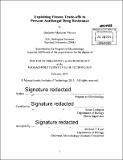Exploiting fitness trade-offs to prevent antifungal drug resistance
Author(s)
Vincent, Benjamin Matteson
DownloadFull printable version (16.24Mb)
Other Contributors
Massachusetts Institute of Technology. Department of Biology.
Advisor
Susan Lindquist.
Terms of use
Metadata
Show full item recordAbstract
The evolution of drug resistance in pathogenic microorganisms is typically viewed as an inevitable consequence of the selective pressures imposed by antimicrobial agents. However, although certain drugs rapidly lose efficacy in the clinic, others remain refractory to resistance. In my thesis, I tested the hypothesis that antifungal drug resistance is the outcome of diverse tradeoffs between the fitness benefits of resistance mutations and their costs upon the adaptive cellular factors that enable the evolution of new traits. I also pursued the discovery of novel small molecule inhibitors of fungal drug resistance to further delineate the cellular processes required to support this phenotype. First, I examined the mechanisms underlying the exceptionally low incidence of resistance to the polyene antifungal amphotericin B (AmB), a mainstay of antifungal therapy for over 50 years. Genome sequencing of AmB-resistant clinical isolates and mutants evolved in the laboratory revealed several loss-of-function mutations in ergosterol biosynthesis as causes of resistance. However, deeper phenotypic profiling of these mutants revealed that they all carried massive costs for the ability to tolerate environmental stressors and deploy virulence factors. I concluded that these costs sharply limit the emergence of resistance to AmB in the clinic. AmB is also extremely toxic to patients, a feature seen in many other resistance-refractory drugs. Collaborating with a synthetic chemistry team headed by Martin Burke (University of Illinois), we demonstrated that new, nontoxic AmB analogs with improved selectivity for the target (ergosterol) still retain the extremely valuable property of evading drug resistance. This finding countered the assumption that narrowing the target specificity of a drug would enable more routes to the emergence of resistance. Separately, I conducted a high-throughput screen for small molecule inhibitors of drug resistance in Candida. This screen identified a fungal-selective inhibitor of cytochrome bc1 of the electron transport chain. Collaborating with chemists (Jean- Baptiste Langlois and Stephen Buchwald) and structural modelers (Raja Srinivas and Bruce Tidor), we optimized the potency and fungal selectivity of this compound. Moreover, these studies provided insight into the role of mitochondrial respiration in fungal host adaptation, immune evasion, and virulence in an animal model. Finally, in the appendix I describe work in progress on the discovery and characterization of a compound that selectively kills Candida by targeting the mitochondrial phosphate transporter. Resistance to this agent sensitizes fungi to azoles and bears severe fitness costs, reminiscent of the case of AmB.
Description
Thesis: Ph. D. in Microbiology, Massachusetts Institute of Technology, Department of Biology, 2015. Cataloged from PDF version of thesis. Includes bibliographical references
Date issued
2015Department
Massachusetts Institute of Technology. Department of BiologyPublisher
Massachusetts Institute of Technology
Keywords
Biology.